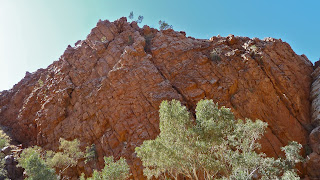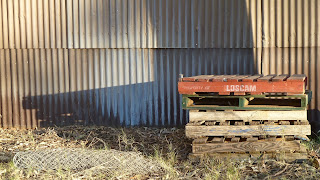There were two slight delays on the way out of town. I had to get a proper photo of the River that isn't most of the time, which involved clambering down by the bridge over the Todd as we turned off the Stuart Highway on to the Ross Highway, just beyond the dramatic gap in the MacDonnell Ranges south of The Alice. There was evidence of gatherings under the bridge – the remnants of fires and, inevitably, a lot of rubbish. I remember from before, almost two decades ago, that beneath the shady gums in the dry riverbed was a popular refuge in which to while away empty days if other options were thin on the ground.
Then there happened to be a Red-tailed Black-cockatoo just sitting by the roadside, which obviously couldn't be passed by.
The Ross Highway takes the low ground at the foot of the southern edge of the Eastern Macs. The red quartzite ridges were once horizontal layers of sand and silt that, during a much later geological era, were heaved up and contorted. Our destination was Ross River Homestead, only 78 kilometres from The Alice but with several points of interest in between. First up were Emily and Jessie Gaps – combined in a Nature Park – which are close to each other and share similar geomorphology and rock art. There was more tipped-on-its-end Heavitree Quartzite and interpretative boards about caterpillars and emu fat.
The large rock painting at Emily Gap (above) depicts the Caterpillar Dreamtime story. I was slightly baffled by this, one of three similar images. Perhaps I should add that the Caterpillars are 'beings' rather than caterpillars as we know them. There are three in the story and they are significant to the Arrernte people of the region. The Caterpillars created the Gaps through the Range. An ancestral hero is said to have cooked and eaten caterpillars here, however. I'm not sure if they were the important ones.
There was more of the same at Jessie Gap. Here the Caterpillar Dreamtime storyline combines with the Emu storyline. An info panel explained that 'the white sand against the ridge to the east of this gap represents the emu fat.' This refers to grey outcrops of limestone – known as the Bitter Springs Formation – that occur between the red quartzite ridges and the highway.
There was more of the same at Jessie Gap. Here the Caterpillar Dreamtime storyline combines with the Emu storyline. An info panel explained that 'the white sand against the ridge to the east of this gap represents the emu fat.' This refers to grey outcrops of limestone – known as the Bitter Springs Formation – that occur between the red quartzite ridges and the highway.
Next up along the Ross Highway was Corroboree Rock. If you're in these parts, don't pass by this dramatic limestone pillar, one kilometre off the highway. It has resisted the powers of erosion better than the shale surrounding it and stands proud. The ancient Bitter Springs Formation from which it originated dates from about 800 million years ago. Later in the day we crossed Bitter Springs Creek. And so a region's names link up and make more sense.
A corroboree is an Aboriginal dance ceremony that may be part of a festival or ritual, or just an informal get-together, which it has come to mean in Australian English, perhaps with a little added boisterousness.
There's a lovely 20-minute walk around the Rock that reveals its changing aspect, and some interesting plants. And it's a Rock with a hole… or two.
You could argue that Trephina Gorge in the Eastern Macs looks like half a dozen other gorges we'd visited and trekked up and down during this trip; that we must surely be gorged out by now. But Trephina was particularly beautiful: there was a tranquility. I wanted to linger longer by the customary sheer quartzite cliffs and fine River Red Gum-lined creek. The only thing missing was a waterhole along Trephina Creek: it's been too dry in these parts.
There is a choice of walks, ranging from an easy-peasy stroll along the creek bed to a 9-km-one-way Ridgetop Walk, classed as difficult. We opted for the moderately difficult 2-km Trephina Gorge Walk along the rim, down into the Gorge and back along the creek bed.
This is East MacDonnell country.
Climbing up to the rim was hot work. My friend took exception to numerous cairns previous walkers had constructed atop prominent rocks along the way. Why do people feel the need to leave their mark in such a wonderful landscape? This had been a much bigger issue in Kings Canyon.
 |
| Painted Dragon |
On the way back to the main road there was an even better view of the River Red Gums. These trees have the ability to withstand raging torrents that occasionally careen down the sandy creek bed. Their trunks are scarred from impacting large debris, and you can often see vegetative material caught against the trunks high above the ground. They are remarkable trees in many respects: they have long roots to reach water far below the river beds but rarely on the surface. Young plants develop a long tap root first to access water and anchor themselves in unstable sand. They then outspread a root network just beneath the surface, to stabilise them further.
And then there was this…
…a Ghost Gum to end all Ghost Gums; the oldest Ghost Gum in the west. It is 33 metres tall and reckoned to be more than 300 years old: it is listed in the National Register of Big Trees as the largest Ghost Gum in Australia. These trees are found in tropical and arid regions of the Northern Territory and outback Queensland. In the Red Centre, their white trunks and branches are particularly outstanding. This Gum is just as remarkable as its River Red neighbour up the road. Groundwater supplies determine whether such a fine specimen such as this flourishes, or whether a more stunted version can just about cling on to a rock face. Like all gums, it is fire-tolerant and generally adaptable.
We were back on the road and nearly there.
 |
| Mt Benstead Creek |
Ross River geology exhibits little variation on the theme: a gorge has cut through layers of sediment deposited originally between 500 and 350 mya as sand and silt beneath a shallow sea. The gorge is behind Ross River Resort, where we were booked for the night. Formerly the 1890s Loves Creek Homestead, it promised 'a bit of outback luxury with an ensuite rustic cabin'. Said cabin had stone floors and hessian-lined walls, and I would have preferred my sleeping bag to the bedlinen. Showering on a chilly night was a challenge in an unheated bathroom but a necessity because of camping in the unknown the following day. But the Ross River welcome was warm.
In rapidly dying sunshine, we went for a wander before supper. At last, some wrought-iron subject matter.
The Homestead resembled the Tardis: the tumble of rooms inside was far bigger than the building. After a communal supper in the huge bar, my friend and I were engrossed in tricky route decision-making when a figure approached our table. It was an acquaintance of mine from far-away-and-out-of-mind Southeast Queensland. I know it's a small world and all that, but this was remote, and it was hard to believe her visit coincided with ours.
Before bed, we walked away from the homestead to observe the glorious Outback sky. Uncertainties about the next day's journey meant an early night and getaway were in order, which was just as well because we could never have read in our cabin. I really should get over my desperate need for bedside lights.
























































Informative Post!
ReplyDeleteI appreciate with this blog. I think this blog is very good and useful for landscaping solution. For more detail about
landscaping brisbane
I'm so glad you like the blog, but please don't use it for advertising unless you'd like to make a donation to a charity of my choice.
ReplyDeleteThis comment has been removed by the author.
ReplyDelete